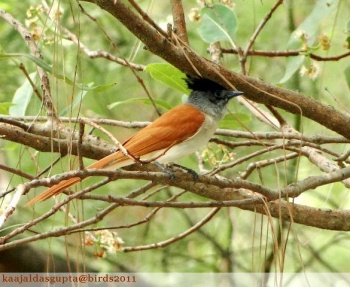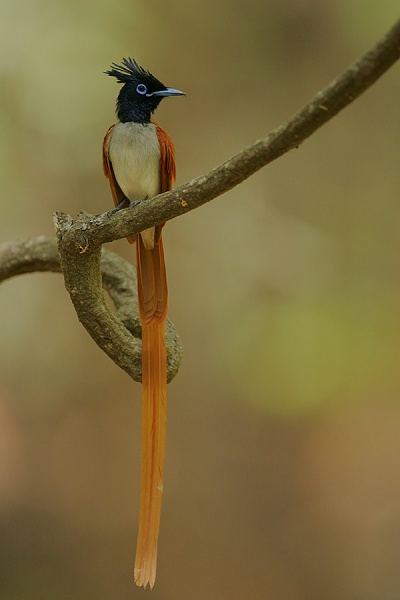- Terpsiphone paradisi
Identification
20-22 cm (7¾-8¾ in), with 20cm long tail streamers
Two very distinct colour phases.
Male
- Black head with a shaggy peaked crest
- Bright blue skin round eye
- Blue bill
- Bright chestnut-brown upperparts and tail
- Greyish breast
- White underparts
Female: duller, greyish throat, shorter tail, shorter crest.
Variations

Photo © by Alok Tewari
Sattal Forest-edge, Altitude 5500 feet, Nainital, Uttarakhand Himalayas, India, 7 April 2023
White morph: black head and neck, rest of body white, apart from black primaries
Distribution
Asia: found in Kazakhstan, Uzbekistan, Turkmenistan, Kyrgyzstan, Tajikistan, Afghanistan, China, Nepal
South Asia: Pakistan, India, Sri Lanka, Bangladesh, Bhutan
Southeast Asia: Indochina, Myanmar, Thailand, Island of Borneo
Taxonomy
Subspecies

Photo © by Kaydeegee2010
Dharamshala,Himachal Pradesh India, June 2011
There are 3 subspecies[1]:
- T. p. leucogaster:
- Mountains of Afghanistan, Pakistan and western India
- T. p. paradisi:
- T. p. ceylonensis:
Habitat
Thick forests and other well-wooded habitats.
Behaviour
Breeding
Both adults construct the cup nest in a tree. The clutch contains 2-5 pinkish-white eggs, with reddish-brown spots. Incubation takes 13-16 days. The young fledge after approximately 11-14 days.
Diet
Their main diet consists of small winged insects, with the occasional addition of praying mantis, grasshopper, moths and butterflies. Has also been observed taking small fish from a garden pond see Gallery image.
They generally forage alone or in pairs, though will occasionally join mixed species flocks.
Vocalisation
It has a sharp zweet call.
Gallery
Click on photo for larger image
Nominate subspecies, male, white morph
Photo © by Maheshwer Rao Naidu
BHILAI, Chhattisgarh, India, July 2017Photo © by Godwin Chan
China, 5 July 2016
References
- Clements, J. F., T. S. Schulenberg, M. J. Iliff, S. M. Billerman, T. A. Fredericks, J. A. Gerbracht, D. Lepage, B. L. Sullivan, and C. L. Wood. 2021. The eBird/Clements checklist of Birds of the World: v2021. Downloaded from https://www.birds.cornell.edu/clementschecklist/download/
- Avibase
- BirdForum Member observations
- Moeliker, K., D. A. Christie, and G. M. Kirwan (2020). Indian Paradise-Flycatcher (Terpsiphone paradisi), version 1.0. In Birds of the World (J. del Hoyo, A. Elliott, J. Sargatal, D. A. Christie, and E. de Juana, Editors). Cornell Lab of Ornithology, Ithaca, NY, USA. https://doi.org/10.2173/bow.aspfly1.01
Recommended Citation
- BirdForum Opus contributors. (2024) Indian Paradise-Flycatcher. In: BirdForum, the forum for wild birds and birding. Retrieved 26 April 2024 from https://www.birdforum.net/opus/Indian_Paradise-Flycatcher
External Links
GSearch checked for 2020 platform.1






